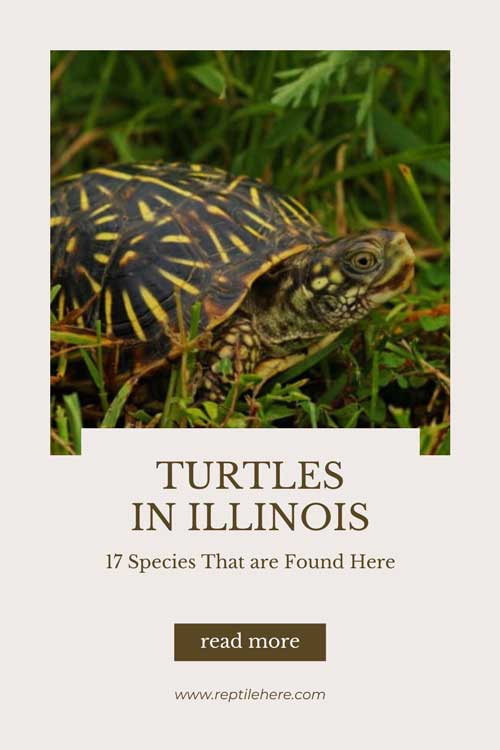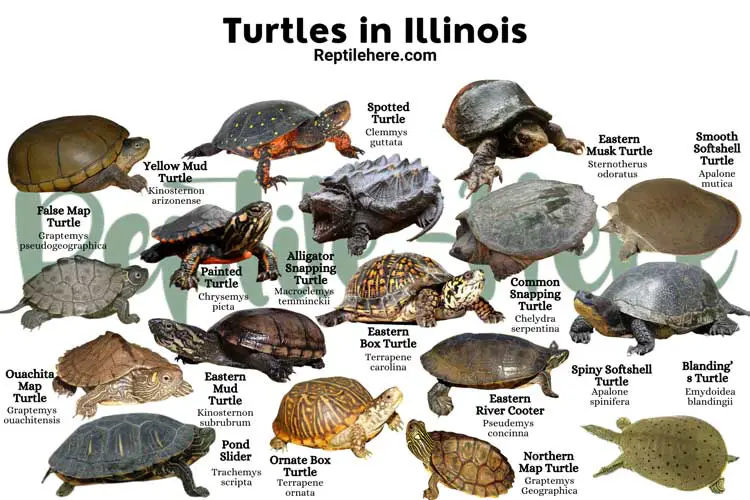Turtles in Illinois – 17 Species That are Found Here
Illinois is home to 17 turtle species that are distributed across the marshes, rivers, ponds, woods, and prairies of the state. These species run from snapping turtles to painted turtles, map turtles, pond sliders, softshell turtles, mud and musk turtles, and even box turtles.
While most of these turtles are of the least concern, some of the turtles inhabiting this state are either vulnerable or endangered species such as the river Cooter, Blanding’s turtles, and spotted turtles.
In this guide, we’re going to look at the species of Illinois and what unique traits each of them has. For each species, we’ll cover basic information such as physical appearance, sewerage adult size, what they eat, where they live, and conservation status.
17 Types Of Turtles in Illinois
Contents
1. Alligator Snapping Turtle
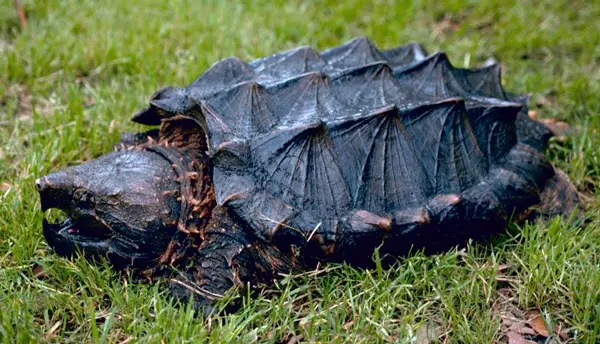
- Scientific name: Macroclemys temminckii
- Common name: Alligator snapping turtle, Snapping turtle
- Family: Chelydridae
- Size: 15 to 26 inches
- Lifespan: 80 to 120 years
- Conservation status: Vulnerable
The alligator snapping turtle is the largest freshwater turtle in Illinois. This species is large than the common snapping turtle. An adult alligator snapping turtle weighs 15 to 20 inches long.
An alligator turtle is characterized by a long, tough shell with trigonal ridges that resemble the back of an alligator (hence the name alligator turtle).
Shell coloring can be black, olive, or brown. Though some people believe that the green tips on the shell ridges are natural, they’re simply algae.
These alligator turtles also prefer living in deeper waters of rivers, canals, lakes, and swamps in Illinois.
As omnivorous species, they hunt their prey (but not actively). They have a unique way of hunting where they lie at the bottom of the water body and open their mouth to show their pink work-like appendage to lure their prey. And when the prey gets close enough, the turtle ambushes it!
Another interesting fact about this turtle is its powerful jaws which can bite with a force of up to 1000lbs!
This makes them extremely dangerous turtles and should NEVER be handled in the wild! Mind you, they have injured even the most experienced herpetologists with their bites.
2. Common Snapping Turtle
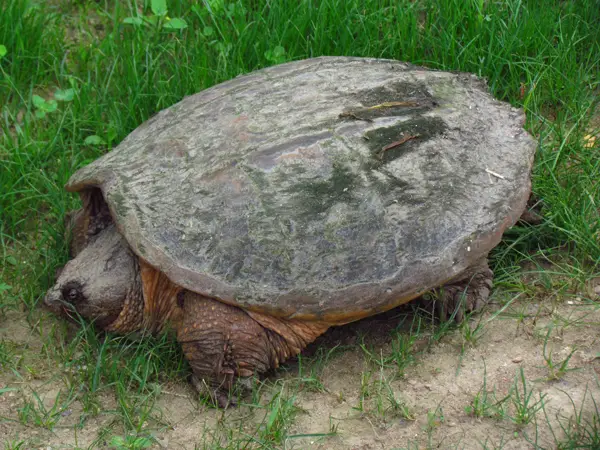
- Scientific name: Chelydra serpentina
- Common name: Snapping Turtle
- Family: Chelydridae
- Size: 8 to 18 1/2 inches
- Lifespan: 30 to 50 years or more
- Conservation status: Least Concern
Common snapping turtles are widespread throughout Illinois. An average adult is pretty large and has a shell length of 18½ inches long.
This species has a chunky head, a long tail, and large webbed feet. The shell color is black or olive and has no distinct pattern. These Illinois snapping turtles are known for their powerful jaws—they’re so strong that these turtles eat other turtles!
You’ll find them in waterbodies with muddy bottoms. Examples include marshes, ponds, lakes, rivers, and even shallow streams. They generally prefer waters with aquatic vegetation in plenty and foods such as fish, frogs, birds, etc.
These Illinois turtles generally show docile behavior but can get quite aggressive if taken out of water. The best way to calm it is to take it back to the waters, where it feels safe.
3. Painted Turtle
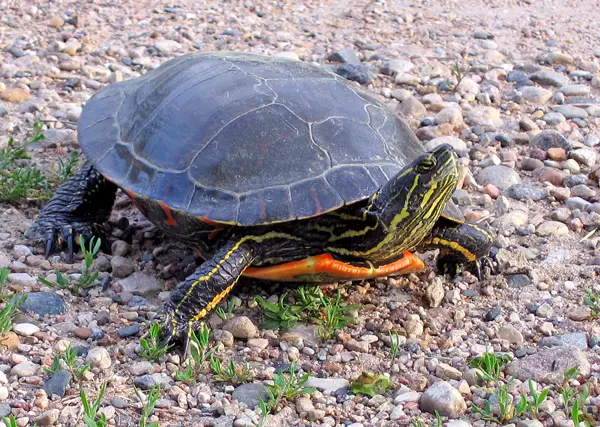
- Scientific name: Chrysemys picta
- Common name: Painted Turtle
- Family: Emydidae
- Size: 4 to 6 inches
- Lifespan: 30 to 50 years
- Conservation status: Least Concern
The Eastern painted turtle is one of the most recognizable turtle species in Illinois, thanks to its beautiful and unique coloring. The bright reds and yellow-green markings on its shell, head, and limbs are no doubt a beauty to behold!
This painted turtle in Illinois has been observed to live near water bodies with minimal movements. Examples include marshes, ponds, slow-moving streams with sandy/muddy bottoms, small lakes, etc.
They also prefer areas with aquatic plants in plenty as they make their primary food source in the wild.
One interesting fact about these Illinois turtles is their ability to hold their breath for up to 30 hours when inside temperate water. Moreover, they’re capable of standing dominant in freezing cold waters for up to 4 months.
Unfortunately, it’s not easy to establish the population of these turtles in Illinois. This is because most people who pet them end up releasing them back into the wild. This contributes to an ever-expanding range plus unstable reproduction rates for these turtles.
4. False Map Turtle
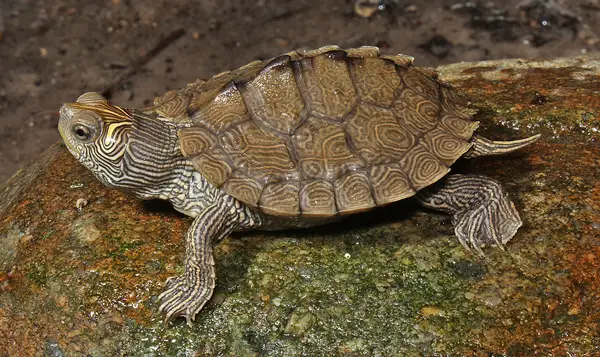
- Scientific name: Graptemys pseudogeographica
- Common name: False Map Turtle, Sawback Turtle
- Family: Emydidae
- Size: 6 to 10 inches (females), 3.5 to 6 inches (males)
- Lifespan: 30 to 50 years
- Conservation status: Least Concern
The false map turtle is a species of map turtle and usually inhabits the large rivers running across the state of Illinois.
These turtles will rarely travel too far from the waters. They like basking on outcrops above water surfaces.
A false map turtle in Illinois usually has a dark shell ranging from brown to black. It also features contour-like yellowish markings. Note that this pattern tends to fade as the turtle ages.
Males usually have a pronounced keel running along their backs. This explains why it is also referred to as the Sawback Turtle.
Lack of colored patches and markings on the head is a key feature that differentiates these turtles from other map turtles.
False map turtles in Illinois are omnivorous and will eat aquatic vegetation, aquatic insects, and crayfish.
5. Ouachita Map Turtle
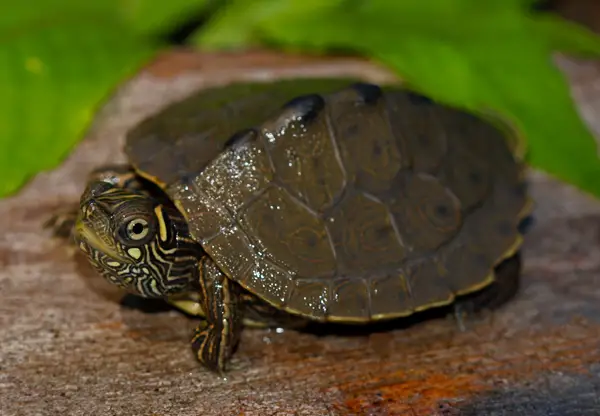
- Scientific name: Graptemys ouachitensis
- Common name: Ouachita Map Turtle, Map Turtle
- Family: Emydidae
- Size: 3 to 5 inches (males), 8 to 10 inches (females)
- Lifespan: 30 to 50 years
- Conservation status: Least Concern
The Ouachita map turtle lives in the northern part of Illinois and is regarded as one of the less popular map turtle species. The turtle makes an excellent choice of pet for many people since it’s easy to care for.
As for its name, this species is named after the river where it was discovered—Ouachita!
Ouachita turtle is medium-to-large sized. The average adult female is 3-5 inches long while the male is 8 to 10 inches long.
It features thin, yellowing lines that form a web on the turtle’s shell (similar to a contour elevation map). Moreover, the turtle has brown to olive coloring, with a light spot under both eyes.
The easiest way to identify this Illinois turtle from other map turtle subspecies is by checking the dots on its face. They usually have 3 prominent spots—under the jawline, under the eye, and behind the eye.
Note that this turtle prefers living in stagnant or slow-moving waters, including ponds, lakes, and streams in Illinois.
It also prefers waters with plenty of vegetation. This species is omnivorous and eats meat, insects, vegetables, fruits, and aquatic vegetation, to name but a few.
6. Northern Map Turtle

- Scientific name: Graptemys geographica
- Common name: Northern Map Turtle, Common Map Turtle
- Family: Emydidae
- Size: 3 to 10 inches
- Lifespan: 30 to 50 years
- Conservation status: Least Concern
The common map turtle is one of the map species that inhabit Illinois. To be more specie, this freshwater turtle resides in the rivers and lakes of Illinois.
It prefers large waterbodies with debris. These offer the perfect spots for basking while the water bodies enable the aquatic animal to spend its hibernation periods in winter completely submerged.
Like other map turtles, this common map turtle gets its name from the map-like pattern on its shell. Its shell is typically darker in color and ranges from brown to black. The map pattern has a lighter coloration.
The common map turtle of Illinois is mainly carnivorous and feeds on mollusks such as clams and snails. It will also eat crayfish and insects. And when animal matter gets scarce, it will turn to plant matter.
Note that it may be difficult to spot a common map turtle in the wild in Illinois. Although active during the day, these turtles are quite shy and will quickly retreat to the waters at the slightest disturbance.
Also read: Turtles in Virginia
7. Eastern River Cooter
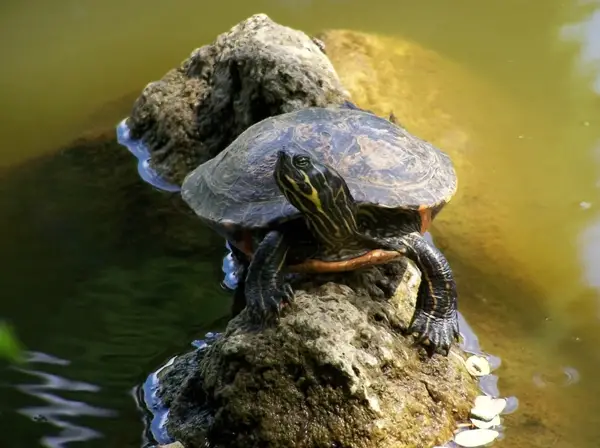
- Scientific name: Pseudemys concinna
- Common name: River Cooter
- Family: Emydidae
- Size: 8 to 12 inches
- Lifespan: 20 to 40 years
- Conservation status: Least Concern
River Cooter turtles are also inhabitants of Illinois. They’re known to be solitary creatures and often like basking alone in the sun. However, they can be sometimes observed sharing habitat with painted turtles and red-eared sliders.
They’re distinguishable by their brown to olive or dark-green outer shell and lighter c-shaped, concentric markings in their scutes. Their skin can be olive or olive-brown in color, with numerous yellow lines.
Most of these turtle adults are around 8 to 12 inches in size, though it’s not rare to come across females with a bigger size—up to 15 inches.
These turtles are pretty fast both on land and in water. They’re found in various freshwater bodies including lakes, ponds, and rivers in Illinois. They’re also found in brackish water.
Their diet is primarily herbivorous and mainly consists of various forms of aquatic vegetation and land plant matter, including fruits and vegetables. They’re however known to occasionally feed on insects and snails.
8. Pond Slider
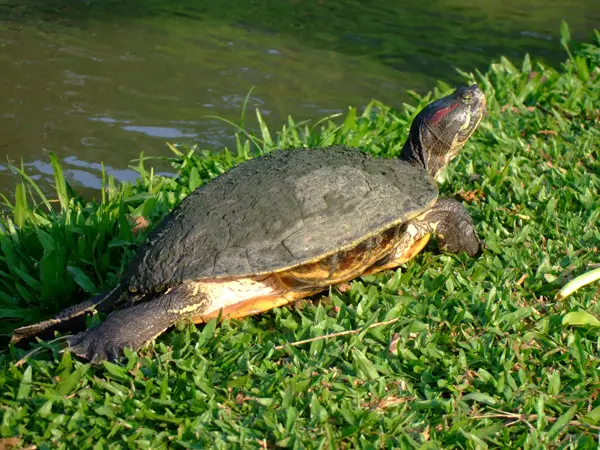
- Scientific name: Trachemys scripta
- Common name: Pond slider
- Family: Emydidae
- Size: 7 to 12 inches
- Lifespan: 30 to 40 years
- Conservation status: Least Concern
Pond sliders is a term used to refer to 3 sub-species of turtles namely yellow belly sliders, red-eared sliders, and Cumberland sliders. For all these 3 subspecies, the males are usually smaller than the females and have thicker tails.
Baby pond sliders are characterized by green shells and a yell-green or dark green skin color. But this color fades as they age. Males, in particular, tend to get darker. Their legs, neck, and head feature yellow marks and stripes alongside this dark appearance.
Red-eared sliders are often confused with painted turtles due to red markings at the jawline plus brightly colored stripes. However, their carapace is more rounded and helmet-like compared to those of painted turtles. Sliders are also bigger than painted turtles in captivity.
Pond sliders in Illinois prefer living in slow-moving waters such as rivers, ponds, lakes, and swamps. They also prefer habitats with muddy bottoms.
As for the diet, pond sliders are omnivorous but they’re more into eating vegetation in their adult age. The young ones are more carnivorous and will eat meat more.
People commonly purchase this turtle species in Illinois as a pet but later on release it into the world when it becomes difficult to take care of or gets too large. But this isn’t a good practice as it can cause pressure on the natural ecosystem.
9. Smooth Softshell Turtle
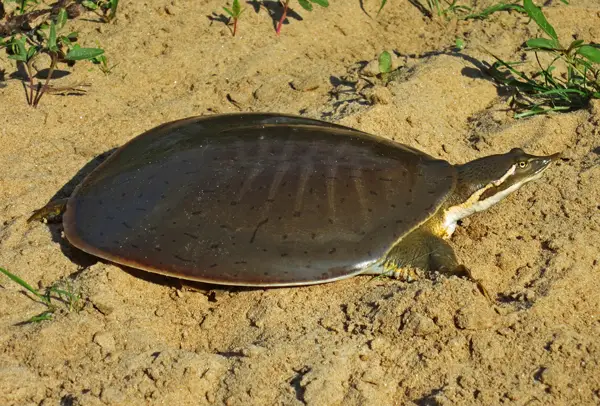
- Scientific name: Apalone mutica
- Common name: Midland Smooth Shell
- Family: Trionychidae
- Size: 6 to 13 inches
- Lifespan: 40 to 60 years
- Conservation status: Least Concern
The smooth softshell turtle boasts its position as the fastest turtle on land in Illinois! Though most people believe these turtles are slow-moving, they must be quick to enable them to outrun their predators given that their soft shells don’t offer much protection.
Shell color of this turtle species ranges from olive to dark brown. The upper part of its shell features dark markings (with female markings appearing in a blotchier pattern than the males’)
The shell of these turtles also appears rounder and flatter, just like other softshell species.
Note that Gulf Coast smooth turtle (Apalone calvata) is the closes relative of this Midland smooth softshell turtle. The main difference existing between these two species is size, with the Gulf coast turtle reaching a maximum of 12 inches long.
Also, the Gulf coast species has no lines on its face while the midland smooth softshell turtle does.
These turtles like inhabiting waterbodies like rivers and streams in Illinois that provide an abundance of mud or sand at the bottom. They can also be found in stagnant waterbodies.
Smooth softshell turtles of Illinois are omnivorous and their diet revolves around aquatic vegetation and insects. However, they have been observed to like meat more than plant matter and will mainly eat snails, insects, and fish.
10. Spiny Softshell Turtle
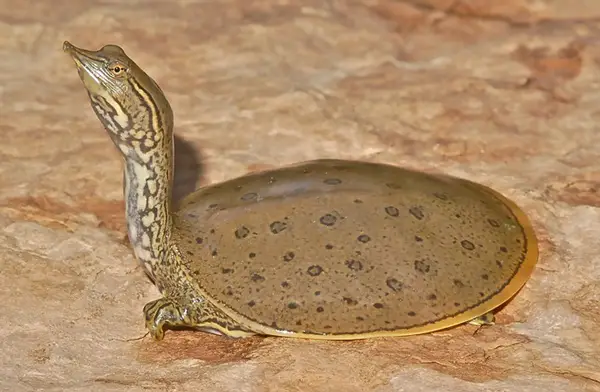
- Scientific name: Apalone spinifera
- Common name: Spiny Softshell Turtle
- Family: Trionychidae
- Size: 5 to 9 inches (males), 12 to 20 inches (females)
- Lifespan: 30 to 70 years
- Conservation status: Least Concern
The Spiny softshell turtle is a medium-to-large freshwater species that lives in Illinois’s lakes, streams, and rivers with muddy or sandy bottoms and little or no vegetation.
Female spiny softshell turtles are usually larger than males. And unlike other turtles, this species has a flexible, leather-like carapace that’s extremely rounded and flattened.
The shell color can be olive grey or yellow-brown. Just like other softshell turtles, this species also has a snorkel-like snout.
The young ones feature well-defined round spots that are easily visible on the shell (though these spots become invisible as they transition to adulthood).
Spiny softshell turtles in Illinois tend to eat anything they find in the waters including crayfish, insects, small fish, and so on. They hunt by burying themselves in the mud or sand while keeping their head uncovered to grab food as it swims by.
These turtles are also able to breathe underwater by taking in oxygen through their throat skin. This is a useful adaptation given that they don’t spend a lot of time out of water.
Other adaptations of these turtles include webbed feed, long claws, and extremely flat shells that enable them to quickly swim away from predators and burry in the muddy bottom of the waters they reside in.
11. Yellow Mud Turtle
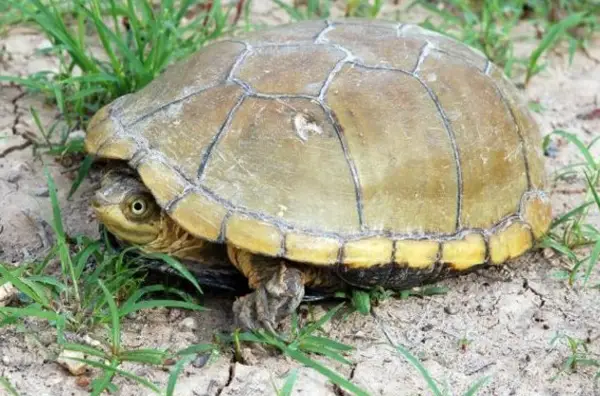
- Scientific name: Kinosternon arizonense
- Common name: Yellow Mud Turtle, Mud Turtle
- Family: Kinosternidae
- Size: 4-5 inches
- Lifespan: 40 years
- Conservation status: Least concern
The Yellow mud turtle is a species native to Illinois and prefers living in any waterbody in Illinois state.
Possible places you can find it includes muddy pools, cattle tanks, irrigation ditches, sewer drains, and even cisterns!
This turtle will spend more time on land migrating to new water sources and is never picky about where it can stay.
It has its upper shell part flattened with colors varying from brown to black or olive. It also features dark brown edges around its scutes. The skin color is usually olive. Males have a sharp or horny end as a distinctive feature.
This Illinois yellow mud turtle is omnivorous like any other mud turtle. its diet is made up of a variety of foods including tadpoles, leeches, crayfish, fairy shrimp, and fish.
It will also eat frogs, slugs, and snails. And as an opportunistic feeder, it will also eat decaying animal and plant matter.
12. Eastern Mud Turtle
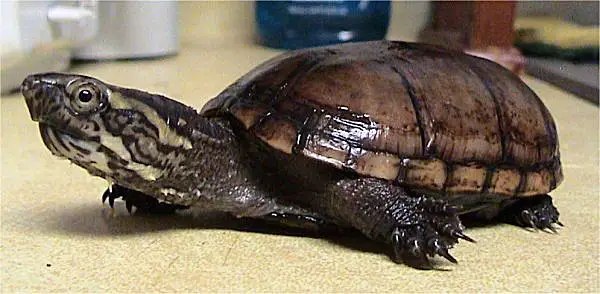
- Scientific name: Kinosternon subrubrum
- Common name: Eastern Mud Turtle, Mud Turtle
- Family: Kinosternidae
- Size: 3 to 5 inches
- Lifespan: 50 years
- Conservation status: Least Concern
The Eastern Mud turtle in Illinois is found in shallow waters including ditches, marshes, wet meadows, and swamps.
This smaller aquatic turtle species is characterized by a smooth and unmarked shell. Yes, it has an incredible plain look, with its upper shell lacking any patterns. The carapace color ranges from dark yellow to black.
The lower side of the shell is also pretty plain, though it usually appears lighter on the upper part. The key distinction of this mud turtle is the stripes on its head which can be white or yellow in color.
One particular feature that sets this turtle apart from others and makes it easily identifiable is the hinges on its lower shell which form a “K” shape when viewed from the sides.
Just as its name suggests, this turtle lives in water bodies with a soft muddy, or sandy bottom. Thus, they can be found in marshes, swamps, and rivers in Illinois.
Since the Illinois eastern mud turtle is omnivorous, it eats meat, fish, snails, insects, and aquatic vegetation as well as plant matter on land.
Unlike other turtles, eastern mud turtles do not hibernate in the cold winter months. Instead, it does the opposite—it becomes dormant in the hot months of summer (this is known as aestivation).
13. Eastern Musk Turtle
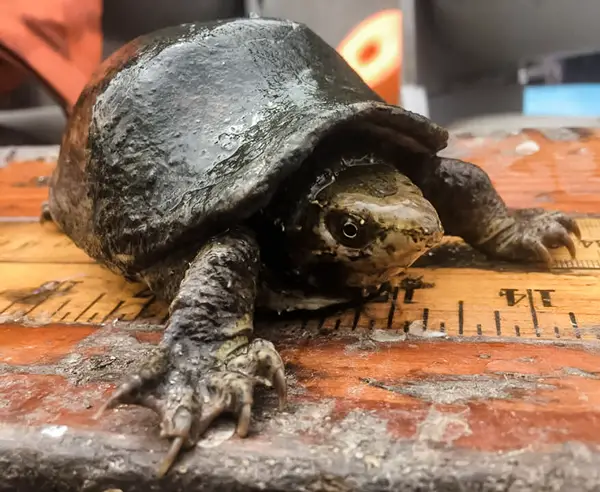
- Scientific name: Sternotherus odoratus
- Common name: Eastern Musk Turtle, Common Musk Turtle, Musk Turtle, Stinkpot
- Family: Kinosternidae
- Size: 2 to 4.5 inches
- Lifespan: 30 to 50 years
- Conservation status: Least Concern
The Eastern Musk Turtle is another aquatic turtle found in Illinois’s slow-moving and sluggish streams as well as still water bodies.
The turtle usually prefers areas with dark crevices, where it can easily hide. It also prefers lots of plant matter to burrow in and hide.
An average adult eastern musk turtle is quite small (2 to 4.5 inches long). It has a pretty plain appearance with highly consistent colors. Both the shell and skin usually share the same color and can range from dark brown to black.
The turtle shell has one unique feature—a ridge traversing its entire shell length. Besides, it has another distinctive feature: two light-colored stripes on its head.
Common musk turtles of Illinois are herbivorous and will eat small aquatic or semi-aquatic animals, carrion, and aquatic vegetation. They will also feed on any other vegetation on land.
When it feels threatened, this turtle species emits a foul odor (a musky odor, hence its name). This scent can be detected in water or on land. It can also easily waft through the air to its predators.
Also, these Illinois turtles are good at climbing trees! This great capability enables them to go high up tree branches to find a safe resting place and avoid predators.
14. Spotted Turtle
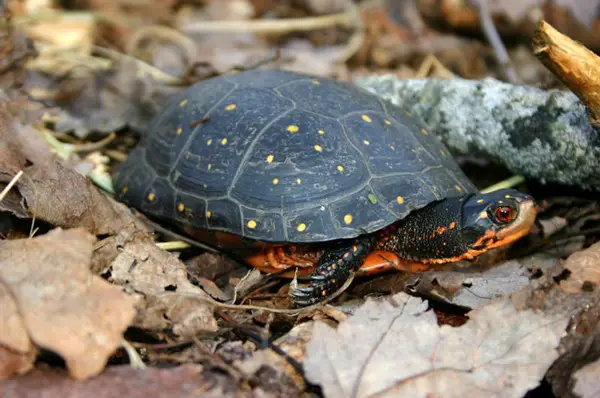
- Scientific name: Clemmys guttata
- Common name: Spotted Turtle
- Family: Emydidae
- Size: 4 to 5 inches
- Lifespan: 25 to 50 years
- Conservation status: Endangered
Spotted turtles in Illinois reside in shallow marshes, swamps, and bogs. They’re semi-aquatic and are comfortable on land just as they are in the waters.
A spotted turtle has a smooth upper shell that ranges from olive to dark brown in color, with some light yellow spots. The neck and head feature irregular orange or yellow spots and streaks. Their tails are fairly long.
The turtles are omnivorous and their diet involves crustaceans, mollusks, insects, and plant matter (occasionally). Note that these turtles are aggressive hunters and will actively seek their prey.
Unfortunately, the population of spotted turtles in Illinois is on the decline due to human interference and habitat loss. Their unique shell patterns make them a favorite species of a pet turtle for many people.
For this reason, they’re listed as endangered and protected by many governing bodies in Illinois.
Above all, the spotted turtles of Illinois are incredibly smart. Studies carried on them using a maze indicate they have the same brain capacity as the mouse!
15. Blanding’s Turtle
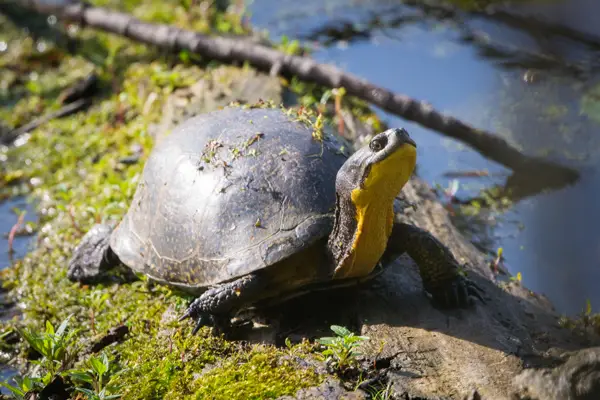
- Scientific name: Emydoidea blandingii
- Common name: Blanding’s Turtle
- Family: Emydidae
- Size: 5 to 8 inches
- Lifespan: up to 80 years (or more!)
- Conservation status: Endangered
Blanding’s Turtle is also known as the “turtle that smiles” and is named in honor of William Blanding, the American naturalist.
The species is semi-aquatic and is categorized under endured species in Illinois. It is mainly concentrated in the northern half of this state, but its population is quite scattered—making it hard to find.
A typical Blanding’s turtle has a dark oval shell covered with faint yellow speckles. The lower side of its shell is usually yellow with black patches.
Blanding’s turtle in Illinois prefers living in marshy habitats. And the fact that it’s losing these favorite habitats is one of the reasons causing its population to decline fast.
Because this turtle species is omnivorous, it feeds on leatherworks, crayfish, and aquatic invertebrates. It also occasionally feeds on plants and doesn’t rely on water to help it sallow its food as it’s the case with most turtle species.
16. Ornate Box Turtle
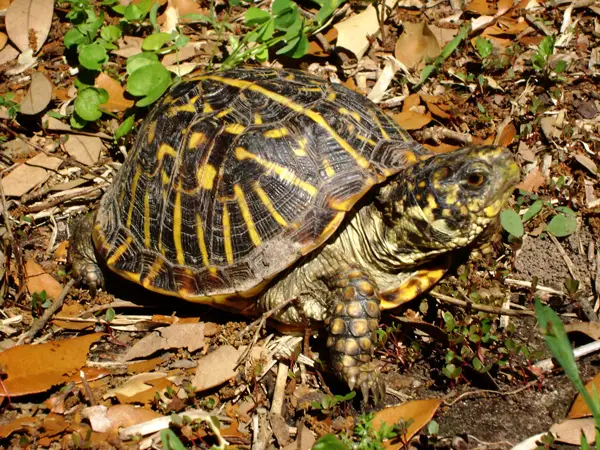
- Scientific name: Terrapene ornata
- Common name: Ornate Box Turtle
- Family: Emydidae
- Size: 5 to 7 inches
- Lifespan: 40 to 60 years
- Conservation status: Near Threatened
Ornate box turtles are present in Illinois and are recognized by the beautiful pattern on their carapace. This eye-pleasing pattern is sometimes referred to as a starburst pattern.
Their skin is grey and may feature yellow or white spots. Male heads occasionally feature green color.
Though there exists little distinction between the males and females of these Illinois box turtles, males are generally smaller than females.
During hot weather, this turtle requires water to help regulate its body temperature.
The Illinois species of turtle are known to hibernate in burrows during cold weather. They’re also capable of surviving in frozen soils for several days.
Being omnivorous in nature, and opportunistic feeders, these turtles will gladly feed anything available to them in their habitat or what’s abundant in a given season. They have been observed eating fruits, vegetables, grasshoppers, and various other insects.
Also, keep in mind that these box turtles in Illinois are pretty shy and don’t like being handled excessively. As such, you may want to avoid approaching them suddenly while in the wild in Illinois.
17. Eastern Box Turtle
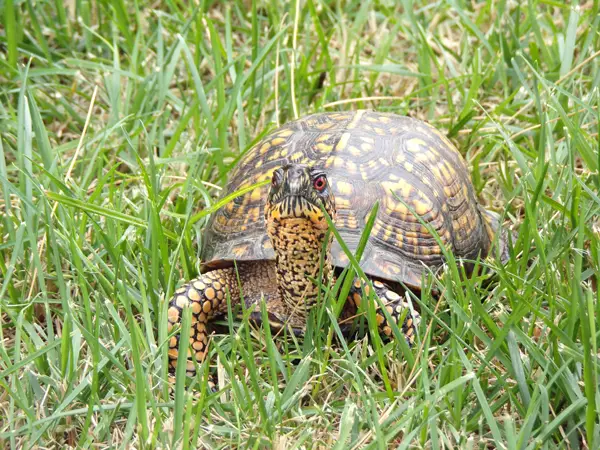
- Scientific name: Terrapene carolina
- Common name: Eastern Box Turtle, Land turtle, Box Turtle
- Family: Emydidae
- Size: 4.5 and 7 inches
- Lifespan: 50 to 100 years
- Conservation status: Vulnerable
The eastern box turtles of Illinois are found in dense thickets and woodland areas. They prefer these areas due to abundant access to sunlight and food sources nearby.
An adult turtle of this species is about 4.5 to 7 inches and weighs just 2lbs. It has a high, domed shell shape with a ridge running from head to toe. The shell of this turtle has varying colors of olive, brown, and tan.
The variation in markings on the shells of these turtles is so variable that you can’t easily recognize one by looking at the shell alone.
These eastern box turtles of Illinois are omnivorous and feed on a variety of foods including insects, meat, fruits, vegetables, and various types of vegetation.
Note that eastern box turtles are taken from the Illinois wild for the pet trade, leading to a decline in their population. For this reason, many states have illegalized capturing and selling of this species.
And those in captivity end up dying due to poor conditions or being abandoned or released back into the wild because they’re too demanding to maintain.
Related: Turtles in Pennsylvania
Conclusion
Illinois state hosts a wide variety of turtle species ranging from snapping turtles to painted turtles, map turtles, pond sliders, softshell turtles, mud and musk turtles, and even box turtles.
Most of these turtles have the conservation status of “Least Concern” and will make good pets that are easy to maintain.
However, some of the species like the Spotted turtles, Blanding’s turtles, and the River Cooter are labeled as endeared or vulnerable species and are under special protection by the relevant authorities.
Having discussed the unique traits and basics of all the species of Illinois, we have no doubt that you now fully understand the different turtles of Illinois.
